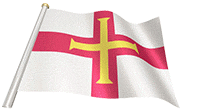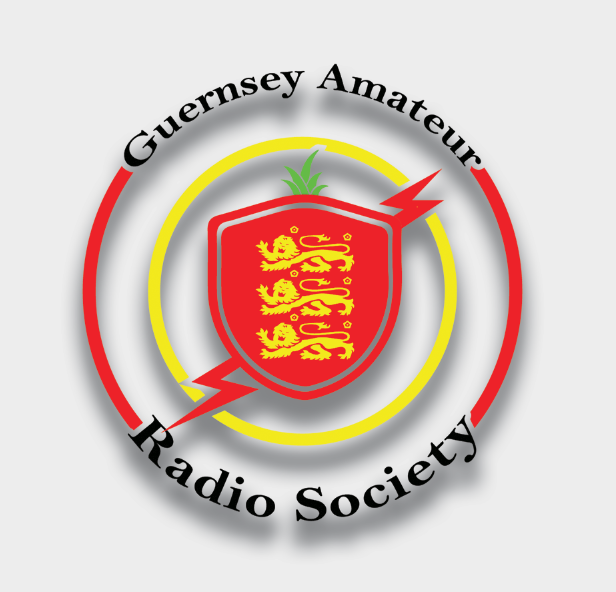 |
|
|
History |
|
 |
|
History
|
Here are some articles that have appeared in the local press in years gone by.... |
|
|||
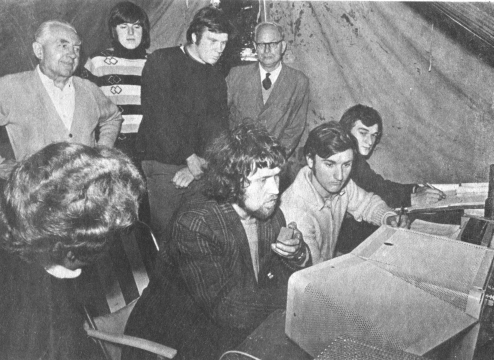 |
||||
| WORKING Non-stop for 24 hours, six Guernsey amateur radio operators dialed worldwide - and contacted 244 others in a competition held by the Radio Society of Great Britain. Starting at 6 p.m. on Saturday, the six, who are members of the Guernsey Radio and Electronic Society, raised a total of 23 countries, including Russia, the United States and Italy TIME LIMIT The object of the contest, the SSB Field Day, is for a group of radio enthusiasts to make as many contacts as possible in the 24 hours allowed. But the contest is held under field conditions. For the Guernsey six-the group can be of any size as long as only one station is used-this meant using a tent and a 900-watt generator in a field. They had two rigs set up in the tent, with one tuned to a different channel in case it was needed, but only used one rig at a time. GRUELLING STINT And after their gruelling radio stint was finished, they all agreed that the session went very well, but do not expect any placings in the contest. The results are due in several months. The picture shows the team and their helpers. From the top left is Mr Harry Le Page, who loaned" the field and did the cooking; Mr Mick Allisett (shortwave listener); John Blackwell (listener); Walter Butt (shortwave operator). Bottom, left to right: Mr Robin Ayres (operator); Mr Jim Martin operator; Mr David Eaton (who logged all contacts) and Mr Steve Henry (check log).. |
||||
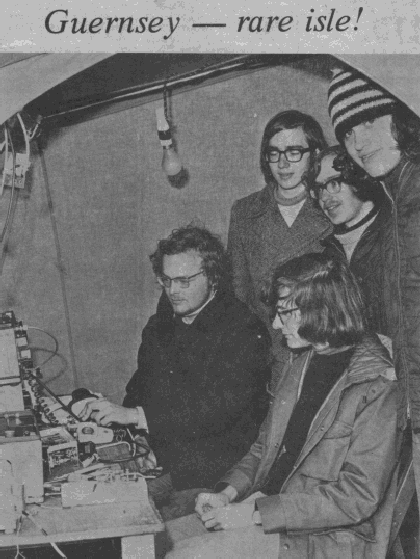 |
||||
| (Dated 1974) GUERNSEY, according to a party of university students, is still something of a rarity. Although there are about 25 radio "hams" here, very few operate on VHF - the wavelength used by the majority of radio amateurs. This means that few "hams" can contact radio enthusiasts in Guernsey, making the island something of a rarity in the radio world, say students from Cambridge University's Radio Society. Four students are camping here for a week while they "dial world-wide" with their radio equipment, which is at Ruette de Ia Tour, Castel. The fifth member of the party, Mike Emery, lives in Guernsey. Pictured in their tent: standing, left to right: Mike Naylor, Nigel Hoult and Martin Phillips; Sitting: Dave Holbourne and Mike Hemery. |
||||
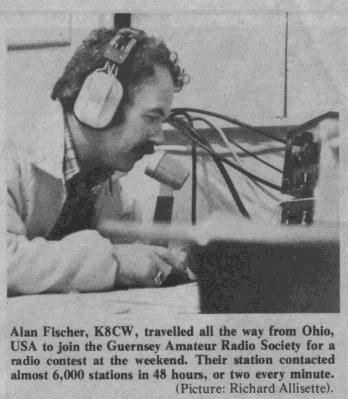 |
||||
| RADIO hams from
Sweden, the USA and Britain came to Guernsey at the weekend and joined
local enthusiasts in a 48 hour radio contest. Nearly 6,000 two-way contacts were made in this time, an average rate of about two a minute for the entire weekend. The station was operated from the headquarters of the Guernsey Radio Society at the Oberlands, St Martin's and more than a hundred different countries were contacted. The contest usually attracts over 2,000 entries from throughout the world and club members are hoping that their score will put them in the top 10 in the world in their class... |
||||
| (No date available) PASSERS-BY were astonished to see a 60ft high steel mast in a field at Le Profond Val. St Peter's, last week-end. With the permission of the Airport Commandant, the Guernsey Radio Club had erected the mast for a day-long annual contest, organised by the Radio Society of Great Britain and called VHF National Field Day. Enthusiastic members of the club tried to make as many contacts as possible with other amateur radio fans in the U.K. and France. Tents were erected near the mast to house club members and equipment. The competition continued without a break between 4 p.m. last Saturday and 4 p.m. on Sunday. During that time members made about 150 contacts, using three different call signs on three frequencies (70 cm, 2 m, and 4m) to identify their station. Many other stations took part in the contest. Members had plenty of fun and gained useful experience from a successful meeting. A mast is erected by the GRC for several contests throughout the year. Others entered involve world-wide operation on HF band. Radio enthusiasts can gain their own "call signs" by taking a City and Guilds examination and then applying to the Home Office for a Class B licence for VHF bands. A Class A licence is obtained by passing a Morse test at 12 words per minute. It allows the owner to operate on all amateur HF bands. It is pointed out by Mr David, Eaton, a member of the GRC, that a newcomer to the hobby does not necessarily need to buy a lot of expensive equipment. The headquarters of the club is at The Lodge. Oberlands, St Martin's. Members meet there on Tuesdays and Fridays.Members of the Guernsey Radio Club, with their St Peter's mast. From left to right Dick Taylor, Steve Henry, Mike Alisette Mike Corbin, Jim Martin, Dick Allisette, Richard Taylor, John Blackwell, Richard Stockwell, Vivien Stockwell (holding baby) and Dave Eaton. |
|
|||
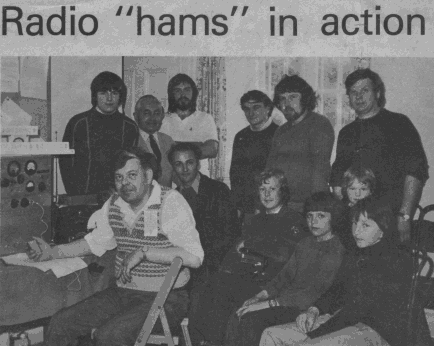 |
||||
|
(No date for
this) Picture 1: Ron Renouf, Society President, keeps a wary eye on GC8BMO, his station. Other members who were dialling worldwide were, from left to right, Mike Allisette, Harry Le Page, Richard Allisette, Steve Henry, Jim Martin, John Blackwell and son, with Mike Corbin sitting left. The three youngsters turned up to watch the proceedings. Picture 2: Seated behind a VHF two-metre band radio, Jon Dauncey, secretary, explains "hamming" to Roger Sarre. |
|
|||
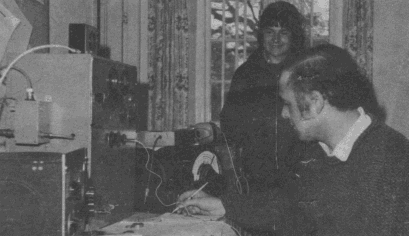 |
